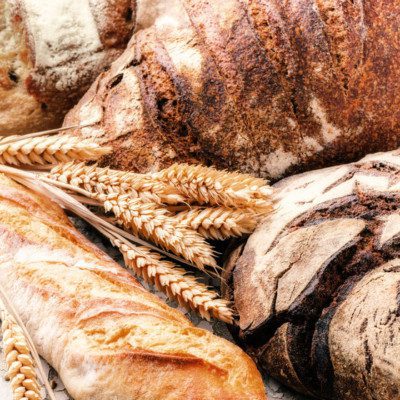
Cultured Wheat
What is Cultured Wheat?
Cultured wheat is a natural, clean label mold inhibitor and antimicrobial agent. It can be used in yeasted and chemically-leavened products such as breads, buns and cakes.
- It lowers dough or batter pH
- It does this by the inhibitory bacteriocin peptides produced by bacteria present in the culture1
Origin
Clean label mold inhibitors like cultured wheat and whey are popular among bakers who want alternatives to chemical preservatives. For example, as replacements for calcium propionate and sorbates.
Function
Cultured wheat provides antimicrobial inhibition of a wide range of spoilage and pathogenic bacteria. Antimicrobial mechanism of this ingredient is due to its ability to:2
- Reduce pH of dough or batter
- Disrupt membrane transport or permeability
- Accumulate anions
- Reduce internal cellular pH
Commercial production
Cultured wheat comes from the fermentation of wheat flour with a specific food-grade bacterial culture. Some commonly used starter cultures include lactic acid bacteria (LAB) and propionic acid bacteria (PAB), such as L. lactis, Lactobacillus spp., Pediococcus spp., and P. freudenreichii subsp. Shermanii. These bacteria produce lactic, propionic and acetic acid, as well as other metabolites with antimicrobial properties.1,3
First, the fermentation of wheat flour is completed. Then, the product is carefully dried, ground and sieved to a powder form to preserve its functionality.
Application
Although this ingredient extends the shelf life of bakery products, comes with it’s share of challenges and considerations.
- It can enhance the flavor and aroma of baked goods when added in adequate amounts. However, too much can have negative effects on product quality.
- In yeasted products, use 1.0–5.0% based on flour weight. Effective mold inhibition using cultured wheat requires up to 10 times the amount of acids themselves.
- Acids present in cultured products are weak, so they dissociate poorly in the product’s aqueous phase. This condition limits their effectiveness in lowering pH to mold inhibiting levels. This also presents a challenge in applications that require a shelf-life similar to CalPro-containing breads.
- Yeast levels should be slightly increased when using cultured wheat because of the negative impact of low pH on yeast activity. Doughs with too low of a pH take longer to fully proof. Also, the oven spring may not be enough for optimum volume.
Difference between cultured wheat and sourdough
Sourdough is based on spontaneous fermentation by wild yeast and lactic acid bacteria, both present naturally in air and in the flour. Sourdough is used at levels 15 to 25% of the total weight of flour.
While cultured wheat contains some of the bacteria microflora found in sourdough, it is a minor component of the formula and does not undergo spontaneous fermentation. Compared to sourdough, cultured wheat is mainly concerned with natural antimicrobial activity. On the other hand, sourdough provides unique flavor and aroma to baked goods.
FDA regulation
Pr. freudenreichii and other starter cultures found in cultured wheat are GRAS (generally regarded as safe) microorganisms. Also, they’re included in the QPS (qualified presumption of safety) list of the EFSA (European Food Safety Authority).3
References
- Davidson, P.M., and Cekmer, H.B. “The use of natural antimicrobials in food: an overview.” Handbook of Natural Antimicrobials for Food Safety and Quality, Woodhead Publishing, Elsevier Ltd., 2015, pp. 1–20.
- Barry-Ryan, C. “Physical and chemical methods for food preservation using natural antimicrobials.” Handbook of Natural Antimicrobials for Food Safety and Quality, Woodhead Publishing, Elsevier Ltd., 2015, pp. 220–221.
- Ruas‐Madiedo, P., and Rodríguez, A. “Non‐starter bacteria ‘functional’ cultures.” Starter Cultures in Food Production, John Wiley & Sons, Ltd, 2017, pp. 64–73.

